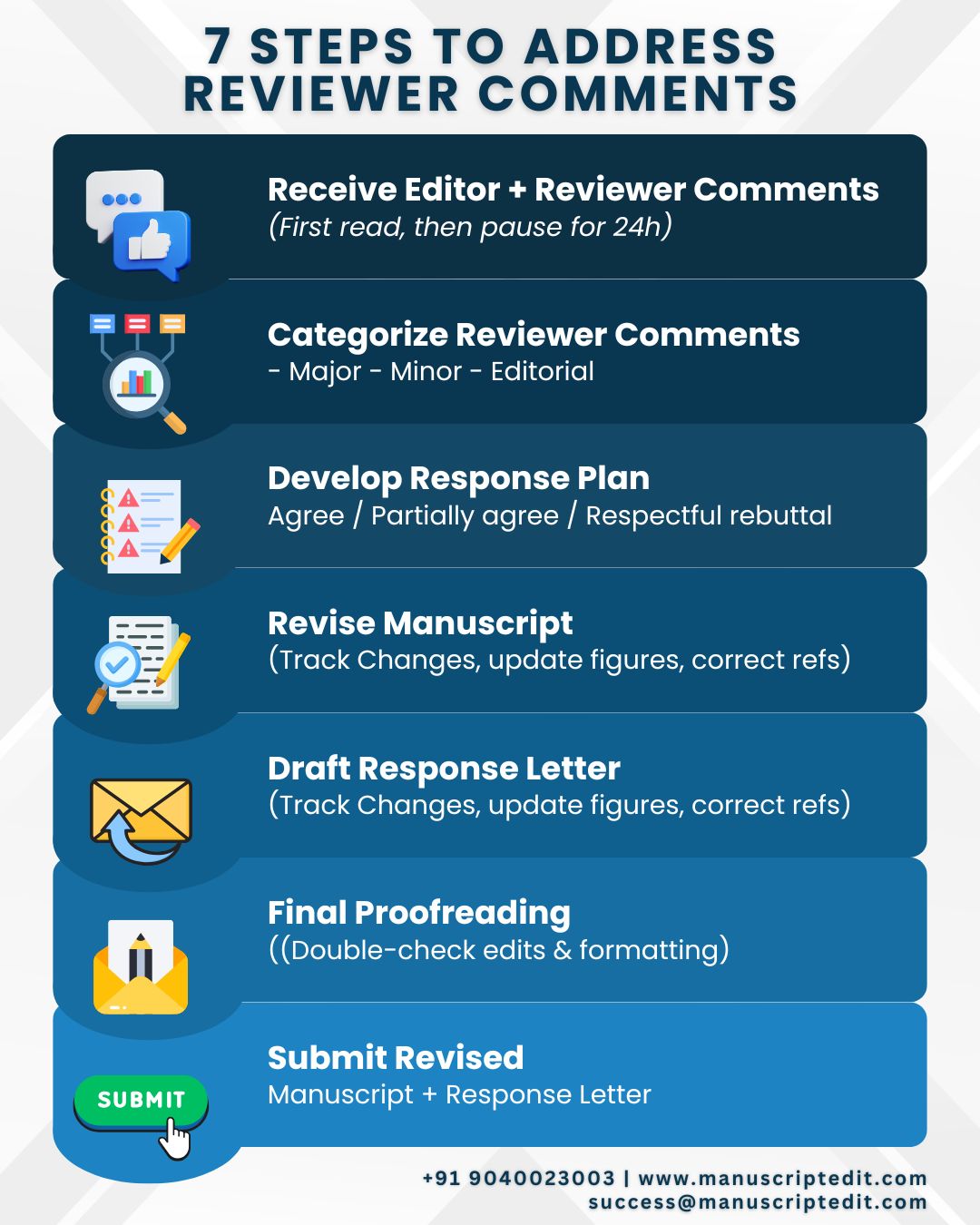
You’ve put in months—or even years—on your research paper. So, you finally send it to a journal and await immediate acceptance. Instead, you hear that you must revise and resubmit along with reviewer comments.
Your instinctive response? Stress. Exasperation. Possibly even bafflement.
But here’s the silver lining: Most articles are rejected or revised at least once before they are accepted. Knowing how to answer reviewer comments correctly can transform a “revise and resubmit” into a final acceptance.
In this guide, we will provide 8 golden tips for dealing with reviewer comments like a pro. Whether the comments are helpful, confusing, or even unjust, these tips will assist you in responding effectively and being published sooner.
(Need professional assistance? Our expert reviewer response assistance can save you time and angst.)
Golden Rule #1: Remain Calm and Read Twice
Why It Matters
Receiving feedback may be taken personally, particularly if reviewers criticize your work. Keep in mind, however—they intend to improve your paper, not attack you.
What to Do
- Step away before reading the feedback. A clear head assists you in responding rationally rather than emotionally.
- Read all the comments twice for the overall impression and then in detail.
- Markdown key points to refer back to later.
Pro Tip: Journals such as Elsevier suggest the CALM approach (Careful, Analytical, Logical, Methodical) when dealing with revisions.
Golden Rule #2: Clearly Understand Every Comment
Why Some Comments Are Confusing
Reviewers are specialists, but they don’t always explain well. Some comments will be vague, such as:
- “The methodology needs clarification.”
- “Results are not well-supported.”
How to Respond
- Break down each comment. What is the reviewer asking for?
- Talk to co-authors if a comment is unclear.
- Find examples (search for “how to respond to reviewer comments example” in your discipline).
Example: If a reviewer comments, “The discussion is too long,” don’t randomly chop up text. Instead, condense the main points and eliminate redundant statements.
Golden Rule #3: Thank the Reviewers Sincerely
Why Gratitude Matters
Reviewers give their time to help improve your work. Begin your reply with appreciation, which is positive and demonstrates professionalism.
How to Word It
- “We sincerely appreciate the effort and time the reviewers spent to review our manuscript.”
- “We are thankful for the feedback, which strengthened our paper.”
Tip: Even when a remark appears to be unjust, remain polite. A defensive tone may spoil your chances.
Golden Rule #4: Edit Thoughtfully, Not Quickly
Common Mistakes to Avoid
- Rushed revisions → Result in missed mistakes.
- Overlooking small comments → Reviewers pick up on it if you omit feedback.
Best Practices
- Reply to all comments, including minor ones.
- If you concur, implement the change and include a short description.
- If you disagree, provide justification supported by evidence.
Need Assistance? Our Response to Reviewer service guarantees you send a polished, professionally revised manuscript.
Golden Rule #5: Defend Your Position Respectfully
When Reviewers Are Wrong
Occasionally, reviewers misinterpret your work. Rather than quarrel, respectfully explain with:
- “We appreciate this concern. However, our data substantiates this method because…”
- “We have included additional clarification in the revised manuscript (Page X, Line Y).”
The Best Way to Respond to Reviewer Comments
- Don’t say, “The reviewer is wrong.” Instead, use: “We respectfully disagree because…”
- Use references (previous studies, further data) to support your response.
Golden Rule #6: Document All Changes
Why This Matters
Editors and reviewers dislike second-guessing what you changed. Make it easier for them with:
- Tracked Changes: Mark each edit in the manuscript.
- Response Letter: Enumerate each comment and your response (Example below).
Golden Rule #7: Adhere to Journal Guidelines
Why so many papers are rejected again
Some writers resubmit without proofreading:
- Word limits (Did your edits leave the paper too long?)
- Formatting rules (Does the journal require a response file separately?)
Fast Checklist Before Resubmitting
Read again the journal’s guidelines for revision.
Check all figures/tables requirements.
Double-check submission deadlines.
Pro Tip: Bookmark the journal’s “For Authors” page for easy return.
Golden Rule #8: Submit Early (But Not in Rush)
Why Timing Matters
- Too slow? The editor may think you are not serious.
- Too fast? You may miss critical revisions.
Ideal Revision Timeline
Week 1: Review comments and map changes.
Week 2-3: Revise and write a response letter.
Week 4: Final proof, then send.
Bonus Tip: If you are short of time, ask the editor politely for an extension.

Conclusion: Turning Feedback into Success
Getting a “revise and resubmit” isn’t failure—it’s a step closer to publication. By following these 8 golden rules, you’ll handle reviewer comments like a pro and boost your chances of acceptance.
Need Expert Help?
Crafting the perfect response takes time. If you’re overwhelmed, our Response to Reviewer service ensures:
- Polished, professional replies
- Clear documentation of changes
- Faster resubmission with confidence
Start today and turn revisions into acceptance! Click Here for Help
Final Checklist Before Resubmitting
Before hitting “submit,” ask:
- Did I address all the comments?
- Is my response letter polite and legible?
- Are all changes highlighted throughout the manuscript?
- Did I adhere to journal guidelines?
If your answer is YES, you’re ready to resubmit!



